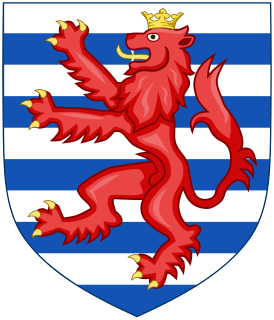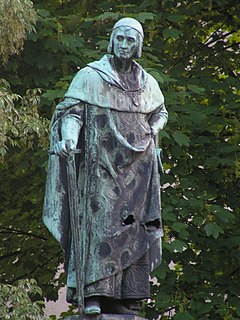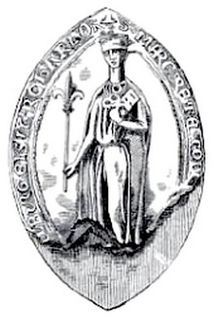Related Research Articles

Louis IV, called the Bavarian, of the house of Wittelsbach, was King of the Romans from 1314, King of Italy from 1327, and Holy Roman Emperor from 1328.

Margaret, often called Margaret of Constantinople, ruled as Countess of Flanders during 1244–1278 and Countess of Hainaut during 1244–1253 and 1257–1280. She was the younger daughter of Baldwin IX, Count of Flanders and Hainaut, and Marie of Champagne.
John II was Count of Hainaut, Holland, and Zeeland.

The Limburg-Luxemburg dynasty, one of several families from different periods known as the Luxembourg dynasty was a royal family of the Holy Roman Empire in the Late Middle Ages, whose members between 1308 and 1437 ruled as King of the Romans and Holy Roman Emperors as well as Kings of Bohemia and Hungary. Their rule was twice interrupted by the rival House of Wittelsbach.

The Avesnes family played an important role during the Middle Ages. The family has its roots in the small village Avesnes-sur-Helpe, in the north of France.

Margaret of Brabant, was the daughter of John I, Duke of Brabant and Margaret of Flanders. She was the wife of Count Henry of Luxemburg and after his election as King of Germany in 1308, she became Queen of Germany.

Henry VI was count of Luxembourg and Arlon from the death of his father, Henry V the Blond in 1281 until his own death at the battle of Worringen, seven years later, when he was succeeded by his son, Henry VII.

Baldwin of Luxembourg was the Archbishop-Elector of Trier and Archchancellor of Burgundy from 1307 to his death. From 1328 to 1336, he was the diocesan administrator of the archdiocese of Mainz and from 1331 to 1337 of those of Worms and Speyer. He was one of the most important German prelates of his age.

Beatrice of Bourbon was a French noblewoman. A member of the House of Bourbon, she was by marriage Queen of Bohemia and Countess of Luxembourg.
Giselbert of Luxembourg was count of Salm and of Longwy, then count of Luxemburg from 1047 to 1059. He was a son of Frederick of Luxembourg, count of Moselgau, and perhaps of Ermentrude of Gleiberg.

Margaret of Bar (1220–1275) was a daughter of Henry II of Bar and his wife Philippa of Dreux. She was Countess of Luxembourg by her marriage to Henry V of Luxembourg. She is also known as Marguerite of Bar.

The Dampierre family played an important role during the Middle Ages. Named after Dampierre, in the Champagne region, where members first became prominent, members of the family were later Count of Flanders, Count of Nevers, Counts and Dukes of Rethel, Count of Artois and Count of Franche-Comté.
Baldwin of Avesnes was a son of Bouchard IV of Avesnes and his wife, Margaret II of Flanders. His parents' marriage was later declared illegal, because his father had already received minor orders. Baldwin was later declared legitimate by the pope, at the instigation of King Louis IX of France. In 1246, Baldwin received Beaumont as an apanage.
Simon II of Sponheim was a German nobleman. He was a member of the House of Sponheim and a ruling Count of the County of Sponheim.
Henry V the Blondell, called the Great, was the count of Arlon from 1226 to his death, lord of Ligny from 1240 to his death, count of Luxembourg and Laroche from 1247 to his death, and the count of Namur between 1256 and 1264 as Henry III. He was the son and successor of Waleran III of Limburg and Ermesinda of Luxembourg.
The House of Luxembourg , also known as the House of Ardenne-Luxembourg in order to distinguish it from later families, were a Lotharingian noble family known from the tenth and eleventh centuries. They are one of the three main branches of the House of Ardenne, along with the House of Ardenne-Verdun, and the House of Ardenne-Bar.
References
| This biographical article about a member of the Luxembourgish nobility is a stub. You can help Wikipedia by expanding it. |